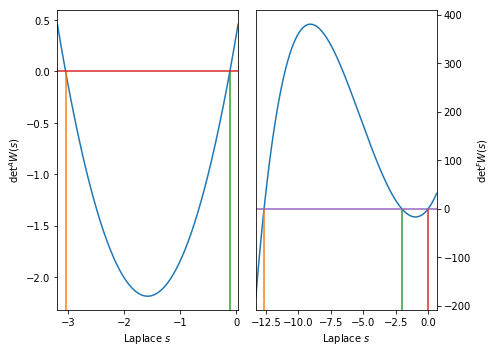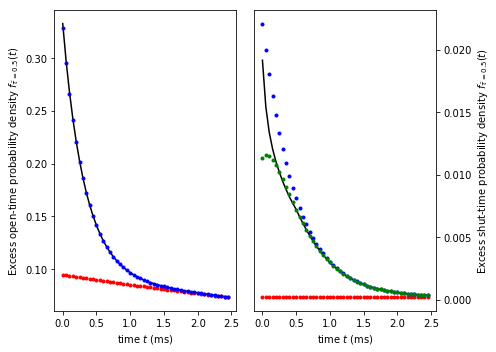CH82 Model¶
The following tries to reproduce Fig 8 from Hawkes, Jalali, Colquhoun (1992). First we create the \(Q\)-matrix for this particular model. Please note that the units are different from other publications.
%matplotlib inline
import numpy as np
import matplotlib.pyplot as plt
from dcprogs.likelihood import QMatrix
tau = 1e-4
qmatrix = QMatrix([[ -3050, 50, 3000, 0, 0 ],
[ 2./3., -1502./3., 0, 500, 0 ],
[ 15, 0, -2065, 50, 2000 ],
[ 0, 15000, 4000, -19000, 0 ],
[ 0, 0, 10, 0, -10 ] ], 2)
qmatrix.matrix /= 1000.0
We first reproduce the top tow panels showing \(\mathrm{det} W(s)\)
for open and shut times. These quantities can be accessed using
dcprogs.likelihood.DeterminantEq. The plots are done using a
standard plotting function from the dcprogs.likelihood package as
well.
from dcprogs.likelihood import plot_roots, DeterminantEq
fig, ax = plt.subplots(1, 2, figsize=(7,5))
plot_roots(DeterminantEq(qmatrix, 0.2), ax=ax[0])
ax[0].set_xlabel('Laplace $s$')
ax[0].set_ylabel('$\\mathrm{det} ^{A}W(s)$')
plot_roots(DeterminantEq(qmatrix, 0.2).transpose(), ax=ax[1])
ax[1].set_xlabel('Laplace $s$')
ax[1].set_ylabel('$\\mathrm{det} ^{F}W(s)$')
ax[1].yaxis.tick_right()
ax[1].yaxis.set_label_position("right")
fig.tight_layout()

Then we want to plot the panels c and d showing the excess shut and open-time probability densities\((\tau = 0.2)\). To do this we need to access each exponential that makes up the approximate survivor function. We could use:
from dcprogs.likelihood import ApproxSurvivor
approx = ApproxSurvivor(qmatrix, tau)
components = approx.af_components
print(components[:1])
[(array([[ 9.99994874e-01, -1.96070450e-02],
[ -2.61427266e-04, 5.12584244e-06]]), -3.050008571211625)]
The list components above contain 2-tuples with the weight (as a
matrix) and the exponant (or root) for each exponential component in
\(^{A}R_{\mathrm{approx}}(t)\). We could then create python
functions pdf(t) for each exponential component, as is done below
for the first root:
from dcprogs.likelihood import MissedEventsG
weight, root = components[1]
eG = MissedEventsG(qmatrix, tau)
# Note: the sum below is equivalent to a scalar product with u_F
coefficient = sum(np.dot(eG.initial_occupancies, np.dot(weight, eG.af_factor)))
pdf = lambda t: coefficient * exp((t)*root)
The initial occupancies, as well as the \(Q_{AF}e^{-Q_{FF}\tau}\) factor are obtained directly from the object implementing the weight, root = components[1] missed event likelihood \(^{e}G(t)\).
However, there is a convenience function that does all the above in the
package. Since it is generally of little use, it is not currently
exported to the dcprogs.likelihood namespace. So we create below a
plotting function that uses it.
from dcprogs.likelihood._methods import exponential_pdfs
def plot_exponentials(qmatrix, tau, x=None, ax=None, nmax=2, shut=False):
from dcprogs.likelihood import missed_events_pdf
if ax is None:
fig, ax = plt.subplots(1,1)
if x is None: x = np.arange(0, 5*tau, tau/10)
pdf = missed_events_pdf(qmatrix, tau, nmax=nmax, shut=shut)
graphb = [x, pdf(x+tau), '-k']
functions = exponential_pdfs(qmatrix, tau, shut=shut)
plots = ['.r', '.b', '.g']
together = None
for f, p in zip(functions[::-1], plots):
if together is None: together = f(x+tau)
else: together = together + f(x+tau)
graphb.extend([x, together, p])
ax.plot(*graphb)
fig, ax = plt.subplots(1,2, figsize=(7,5))
ax[0].set_xlabel('time $t$ (ms)')
ax[0].set_ylabel('Excess open-time probability density $f_{\\bar{\\tau}=0.2}(t)$')
plot_exponentials(qmatrix, 0.2, shut=False, ax=ax[0])
plot_exponentials(qmatrix, 0.2, shut=True, ax=ax[1])
ax[1].set_xlabel('time $t$ (ms)')
ax[1].set_ylabel('Excess shut-time probability density $f_{\\bar{\\tau}=0.2}(t)$')
ax[1].yaxis.tick_right()
ax[1].yaxis.set_label_position("right")
fig.tight_layout()

Finally, we create the last plot (e), and throw in an (f) for good measure.
fig, ax = plt.subplots(1,2, figsize=(7,5))
ax[0].set_xlabel('time $t$ (ms)')
ax[0].set_ylabel('Excess open-time probability density $f_{\\bar{\\tau}=0.5}(t)$')
plot_exponentials(qmatrix, 0.5, shut=False, ax=ax[0])
plot_exponentials(qmatrix, 0.5, shut=True, ax=ax[1])
ax[1].set_xlabel('time $t$ (ms)')
ax[1].set_ylabel('Excess shut-time probability density $f_{\\bar{\\tau}=0.5}(t)$')
ax[1].yaxis.tick_right()
ax[1].yaxis.set_label_position("right")
fig.tight_layout()

from dcprogs.likelihood import QMatrix, MissedEventsG
tau = 1e-4
qmatrix = QMatrix([[ -3050, 50, 3000, 0, 0 ],
[ 2./3., -1502./3., 0, 500, 0 ],
[ 15, 0, -2065, 50, 2000 ],
[ 0, 15000, 4000, -19000, 0 ],
[ 0, 0, 10, 0, -10 ] ], 2)
eG = MissedEventsG(qmatrix, tau, 2, 1e-8, 1e-8)
meG = MissedEventsG(qmatrix, tau)
t = 3.5* tau
print(eG.initial_CHS_occupancies(t) - meG.initial_CHS_occupancies(t))
[[ 4.33877934e-12 -4.33864056e-12]]